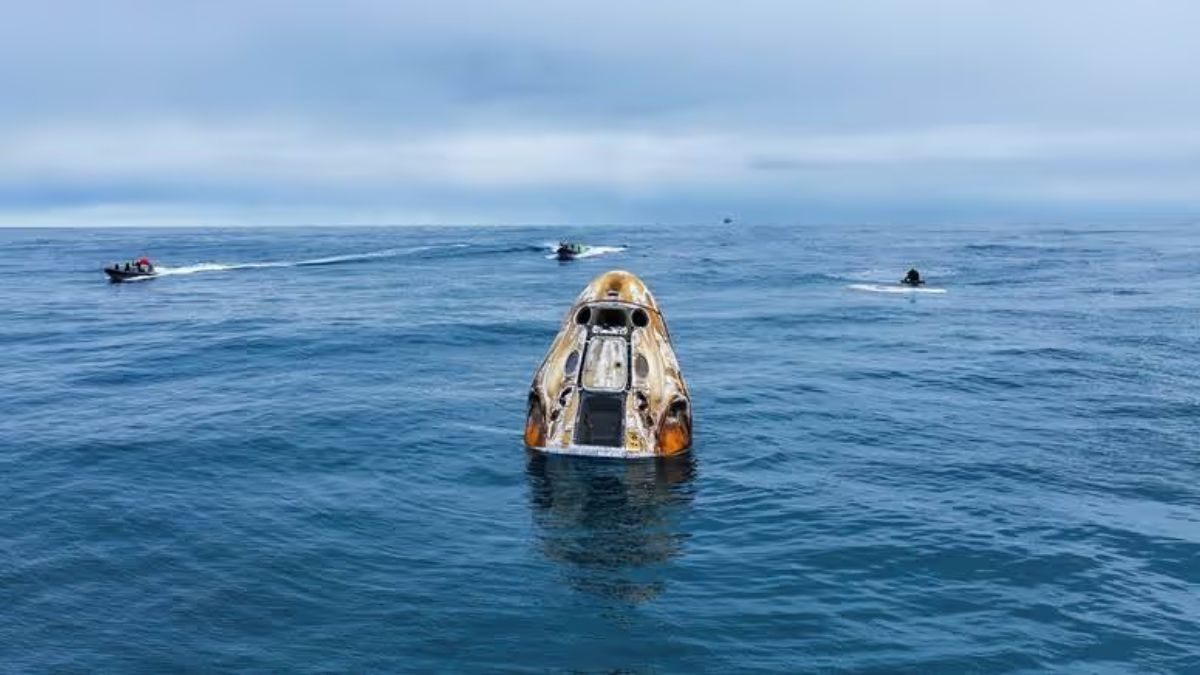Riding the fire trail: Axiom mission 4 re-entry, explained
 From the Axiom Mission 3: SpaceX Dragon spacecraft carrying the Ax-3 crew splashed down off the coast of Daytona, Florida on February 9 2024 [File] | Axiom Space
From the Axiom Mission 3: SpaceX Dragon spacecraft carrying the Ax-3 crew splashed down off the coast of Daytona, Florida on February 9 2024 [File] | Axiom Space
The Axiom Mission 4 (Ax-4), launched on June 25 2025 from NASA’s Kennedy Space Center in Florida, is now entering its final stage—a safe return to Earth.
This private spaceflight, led by Axiom Space with support from SpaceX and NASA, included four astronauts: Group Captain Shubhanshu Shukla from India, Peggy Whitson from the USA, Sławosz Uznański from Poland, and Tibor Kapu from Hungary. For India, Poland, and Hungary, this was their first human mission to the International Space Station (ISS) and their return to human spaceflight after over four decades.
Once the 14-day mission is over, the team will return to Earth. Experts point out that their return to Earth will take nearly 17 hours from the time they undock from the ISS to when they splash down in the Pacific Ocean. This long duration is crucial to ensure the spacecraft lands in a safe zone and follows all necessary safety protocols.
“The first step begins when the astronauts pack up their equipment and research samples. They double-check all the systems inside their SpaceX Crew Dragon capsule, named “Grace.” Once the systems are confirmed to be working well, the hatch between the ISS and the capsule is sealed. This happens when the ISS is orbiting about 400 km above Earth. The temperature inside the capsule remains comfortable at around 20–25°C,” explained space expert Girish Linganna.
After sealing the hatch, the spacecraft will undock from the ISS. This is an automatic process using small thrusters to gently move the spacecraft away. Though the outside space temperature is extremely cold at –273°C, the cabin stays warm and safe. Once free from the ISS, the capsule will start slowly drifting in orbit for several hours. During this time, its flight path will be adjusted using small thruster burns. These adjustments will make sure the capsule aligns exactly with the selected splashdown site in the Pacific Ocean.
The next step is the separation of the service module or trunk, which is a section of the spacecraft that carries solar panels and extra hardware. This part is no longer needed during re-entry and is jettisoned safely, burning up in the atmosphere.
Post that the most critical part comes in—the deorbit burn. “Deorbit happens at about 350km above Earth. The spacecraft fires its engines to reduce its speed and drop out of orbit. This burn is what begins the journey back to Earth. At around 120km altitude, the capsule starts entering Earth’s atmosphere. This phase creates extreme friction, heating the outer surface to about 1,900–2,200°C. Thankfully, the capsule is equipped with a heat shield that absorbs the heat and keeps the crew safe inside. The astronauts feel strong G-forces, and a brief communication blackout can occur due to hot plasma forming around the spacecraft,” added Linganna.
As the capsule descends, it will continue to slow down naturally due to thicker air layers. At 18,000 feet (5.5km), two small drogue parachutes will be released. These will help stabilise the capsule. A few seconds later, at about 6,000 feet (1.8km), four large main parachutes will open to slow down the descent further.
Finally, the spacecraft will make a soft splashdown in the Pacific Ocean, possibly near the coast of California, around 6.30pm IST on July 9 or 10, 2025. The sea temperature is usually between 15°C and 20°C. The spacecraft is designed to float, allowing the SpaceX recovery team to reach it quickly.
The recovery team will arrive in small boats and first check for any fuel leaks or hazards. Once everything is safe, they will open the hatch and help the astronauts out. Since the crew has spent nearly two weeks in microgravity, their muscles will need time to adjust. They may be carried on stretchers to avoid strain.
After the astronauts are brought on board the recovery ship, they undergo basic medical checks. They are then flown back to a secure base, most likely in Florida or California, where they will begin their full post-mission recovery process.
Sci/Tech